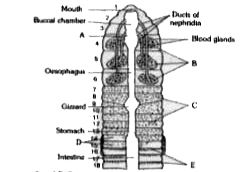यदि सेल के सिरों का विभवांतर V तथा विधुत - वाहक बल E हो तो किस स्थिति में - (I) V - E, (ii) V=E, (iii) V+E, (iv) V=0 होगा ?
(i) सेल निरावेशित हो रहा है , (ii ) सेल परिपथ खुला है अथवा सेल का आंतरिक प्रतिरोध शून्य है, (iii ) सेल आवेशित हो रहा है , (iv ) सेल परिपथ लघुपथित है
Topper's Solved these Questions
- विद्युत धाराBOOK - BALAJI PUBLICATIONCHAPTER - विद्युत धाराEXERCISE - दीर्घ उत्तरीय प्रश्न
35 Videos
- विद्युत धाराBOOK - BALAJI PUBLICATIONCHAPTER - विद्युत धाराEXERCISE - आँकिक प्रश्न (हल सहित )
85 Videos
- विद्युत धाराBOOK - BALAJI PUBLICATIONCHAPTER - विद्युत धाराEXERCISE - NCERT पाठ्य-पुस्तक के हल
28 Videos
- विघुतचुंमबकीय तरगेBOOK - BALAJI PUBLICATIONCHAPTER - विघुतचुंमबकीय तरगेEXERCISE - अतिरिक्त अभ्यास
5 Videos
- वैधुत आवेश तथा क्षेत्रBOOK - BALAJI PUBLICATIONCHAPTER - वैधुत आवेश तथा क्षेत्रEXERCISE - NCERT पाठ्य-पुस्तक के हल
31 Videos
Similar Questions
विधुत धारा से आप क्या समझते है ? विधुत धारा तथा घनत्व में क्या अन्तर है ?
View Solution0.5मिमी त्रिज्या के तार में 0.5 ऐम्पियर की धारा है । तार में मुक्त इलेक्ट्रोनो की संख्या 4×1028प्रति मीटर3 है । ज्ञात कीजिये - (i) तार में धारा घनत्व , (ii ) मुक्त इलेक्ट्रोनो का अनुगमन वेग ।
View Solutionकिसी कार की संचायक बैटरी का विधुत वाहक बल 12V है । यदि बैटरी का आंतरिक प्रतिरोध () हो, तो बैटरी से ली जाने वाली अधिकतम धारा का मान क्या है ?
View Solutionकल्पना कीजिए कि निर्वात् में एक वैद्युतचुम्बकीय तरंग का विद्युत क्षेत्र
E={(3.1N/C)cos[(1.8rad/m)y+(5.4×106rad/s)t]}ˆi है
(a) तरंग संचरण की दिशा क्या है?
(b) तरंगदैध्ध्य λ कितनी है?
(c) आवृत्ति v कितनी है?
तरंग के चुम्बकीय क्षेत्र सदिश का आयाम कितना है?
(e) तरंग के चुम्बकीय क्षेत्र के लिए व्यंजक लिखिए।
View Solutionवायु के एक-दूसरे से 30 सेमी दूरी पर रखे दो छोटे आवेशित गोलों पर क्रमश: 2×10−7C तथा 3×10−7C आवेश है, उनके बीच कितना बल है?
View SolutionA voltmeter and an ammeter are connected in series to an ideal cell of emfE. The voltmeter reading is V, and the ammeter readings is I. Then
(i) V<E (ii) the voltmeter resistance is V/I
(iii) the potential difference across the ammeter is E−V
(iv) Voltmeter resistance + ammeter resistance = E//I
Correct statements are
View SolutionFour charges , all of the same magnitude , are placed at the four corners of a square . At the centre of the square , the potential is V and the field is E. By suitable choice of the signs of the four charges ,which of the following can be obtained?
(i) V=0,E=0
(ii) V=0,E≠0
(iii) V≠0,E=0
(iv) V≠0,E≠0
View SolutionThe electric field and the electric potential at a point are E and V respectively.
View SolutionGiven the following table

Computer i) E(4X+5) ii) E(X2)
iii) V(X) iv) V(2X±3)
View Solutionदिए गए आरेख में नामांकित संरचनाओं (A - E) को सूची I - V में से पहचानिए

I. पतीय नेफ्रीडिया
II. ग्रसनी
III. अध्यावरणी नेफ्रीडिया के जंगल
IV. अध्यावरणी नेफ्रीडिया
V. ग्रसनी नेफ्रीडिया के गुच्छे
∣∣ ∣ ∣ ∣ ∣ ∣∣ABCDE(a)IIIIIIVIV(b)IIIVVIIII(c)IIVIVIIII(d)IIIIIIIVV∣∣ ∣ ∣ ∣ ∣ ∣∣
View SolutionLet V and E denote the gravitational potential and gravitational field at a point . It is possible to have (a)V=0 and E=0 , (b)V=0 and E ne 0 (c) V ne 0 and E=0 , (d) V ne 0 and E ne 0
View SolutionLet V and E denote the gravitational potential and gravitational field at a point. It is possible to have a) V = 0 and E = 0 b) V = 0 and E ne 0 c) V ne 0 and E = 0 d) V ne0 and E ne 0
View SolutionLet V and E denote the gravitational potential and gravitational field at a point. It is possible to have (a) V = 0 and E = 0 (b) V = 0 and E != 0 (c) V != 0 and E = 0 (d) V != 0 and E != 0
View SolutionLet V and E denote the gravitational potential and gravitational field at a point. It is possible to have
(a) V = 0 and E = 0 (b) V=0 and E≠0
(c) V≠0 and E=0 (d) V≠0 and E≠0
View SolutionA voltmeter and an ammeter are connected in series to an ideal cell of emfE. The voltmeter reading is V, and the ammeter readings is I. Then
(i) V<E (ii) the voltmeter resistance is V/I
(iii) the potential difference across the ammeter is E−V
(iv) Voltmeter resistance + ammeter resistance = E//I
Correct statements are
View Solution
